Part III Assistance for Each Region

A Japan Overseas Cooperation Volunteer (JOCV) giving environmental education to the children from a village in Iquitos City in the Loreto Region in the Peruvian Amazon (Photo: JICA)
Challenges and problems vary according to countries and regions. Hence, it is necessary to implement cooperation that responds to the respective situations of each region. Based on the economic and social backgrounds of the problems faced by each region, Japan strives to solve the problems in developing countries through providing more focused cooperation in a strategic, effective, and flexible manner while coping flexibly and responding to rapidly changing situations.
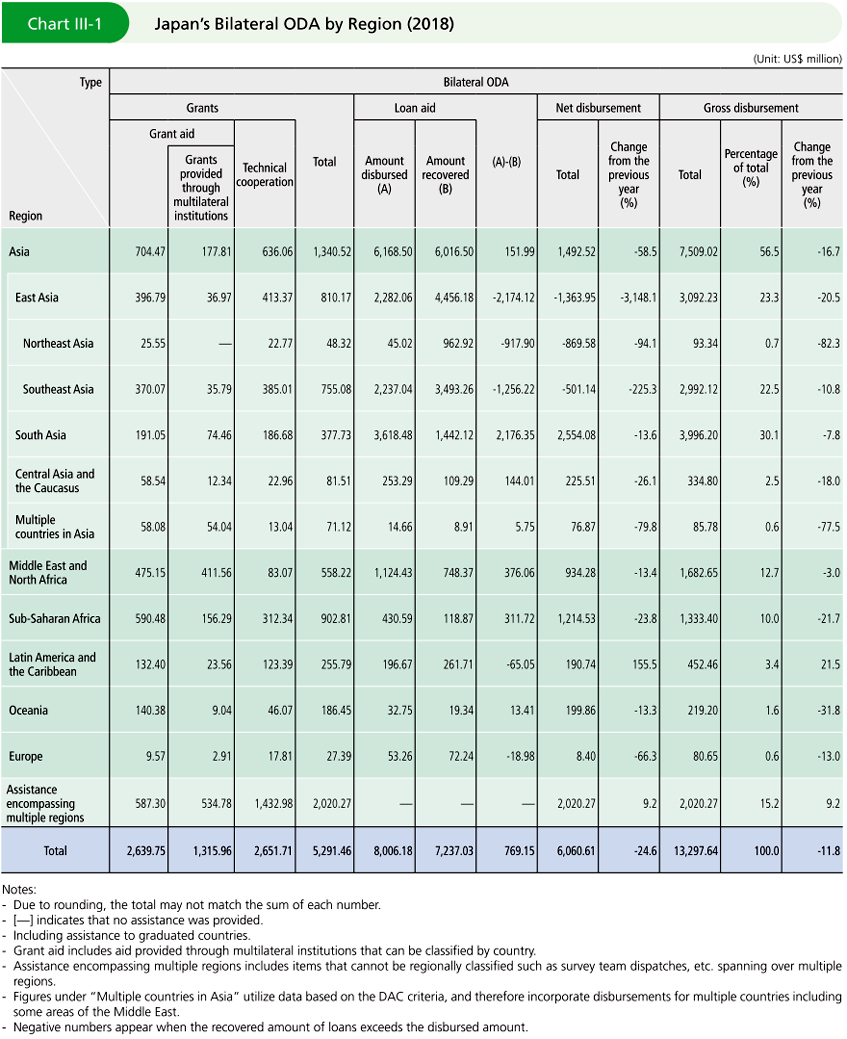
1 East Asia
East Asia consists of a variety of nations, which include countries such as the Republic of Korea and the Republic of Singapore, which have already attained high economic growth and transitioned from the category of aid recipients to that of donors; least developed countries (LDCs) such as Cambodia and Laos; countries such as Indonesia and the Philippines, which still show large income disparities domestically despite dramatic economic growth; and countries, such as Viet Nam, which are shifting to a market-driven economy. Japan has close relationships with these countries in all aspects of politics, economy, and culture, hence the stability and development of the region significantly impacts the security and prosperity of Japan as well. From this perspective, Japan is engaging in development cooperation that responds to the diverse socio-economic circumstances of East Asian countries and to the changes in the type of development cooperation required.
●Japan’s Efforts
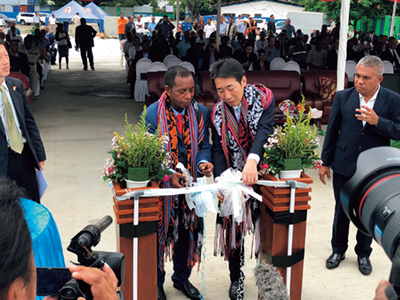
Parliamentary Vice-Minister for Foreign Affairs NAKAYAMA Norihiro attending the completion ceremony for the ferry terminal of Dili Port in Timor-Leste, which was relocated and expanded through Grant Aid (January 2020)
Japan has contributed to the remarkable economic growth of East Asia by implementing development cooperation that combines ODA with trade and investment, including the development of socio-economic foundations through quality infrastructure investment, support for the development of institutions and human resources, promotion of trade, and revitalization of private investment. In recent years, Japan aims to further enhance open regional cooperation and integration while sharing basic values, to promote mutual understanding, and to maintain consistent regional stability. Therefore, Japan strives to proactively provide assistance in areas such as disaster risk reduction, environment and climate change, health and medical care, strengthening the rule of law, and maritime safety, in parallel with the assistance for developing infrastructure. Japan is also working to promote mutual understanding through large-scale youth exchanges, cultural exchanges, and projects to spread the Japanese language.
In order for Japan and other East Asian countries to achieve further prosperity, it is important to assist Asia to become “a center of growth open to the world.” Accordingly, Japan is providing assistance to strengthen Asia’s growth and to expand domestic demand in each country.
Mongolia
- (1) Project for the Construction of Mongolia-Japan Teaching Hospital
Grant Aid (May 2015 - July 2019 (Completed)) - (2) Project for the Establishment of Hospital Management and Medical Services at the Mongolia-Japan Teaching Hospital
Technical Cooperation Project (March 2017 - (ongoing))
In Mongolia, young medical staff including doctors and nurses who have just graduated from university often engage in medical care service soon after their graduation without receiving sufficient clinical training and practical guidance, particularly those working in the countryside. The Mongolian National University of Medical Sciences, which is Mongolia’s only national university for medical science, produces more than 90% of the country’s medical personnel. While its education system has worked well, it was not adequate enough to serve as a center of practical education and research for students, as it did not have a university hospital.
In response to these circumstances, the Mongolia-Japan Teaching Hospital, the country’s first university hospital, was constructed through grant aid from the Japanese government. The hospital is expected to provide advanced medical services and enhance the development of human resources as a center for high quality medical personnel training and research, contributing to the improvement of the health conditions of the Mongolian people.
In addition to the construction of the hospital, the Government of Japan has started a technical cooperation project supporting the Mongolian National University of Medical Sciences to operate and manage the new hospital properly from the preparatory phase of the hospital’s opening. Experts from Japanese medical organizations including the medical department of Tokushima University, Ehime University, and other institutions, which have long-standing relationships with the Mongolian National University of Medical Science, have been taking a leading role in the guidance. The Mongolia-Japan Teaching Hospital has introduced Japanese-style patient-centered medical services and established the country’s first patient support center, which alleviates the patients’ and their families’ concerns and offers consultations.
In October 2019, the operation of the hospital began with the start of outpatient care, and the hospital is preparing to set up an inpatient ward and an emergency service facility. Japan will continue to provide technical assistance to the hospital until all functions can be amply exerted to meet the high expectations of the Mongolian people toward the hospital.
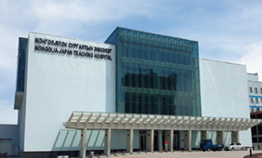
The Mongolia-Japan Teaching Hospital, constructed through grant aid (Photo: JICA)
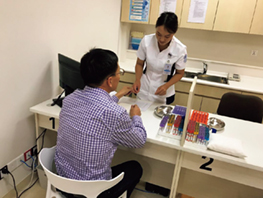
A blood test being taken inside the finished hospital
Support for Southeast Asia
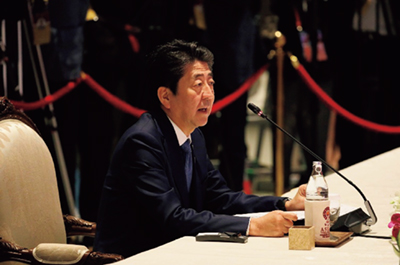
Prime Minister Abe announcing the launch of the “Initiative on Overseas Loans and Investment for ASEAN” at the Japan-ASEAN Summit Meeting (November 2019) (Photo: Cabinet Public Relations Office of the Government of Japan)
The countries of the Association of Southeast Asian Nations (ASEAN)(Note1) are located on Japan’s sea lanes and have strong economic ties with Japan, as approximately 13,000 Japanese companies (business establishments) have been operating in the region as of October 2018. The ASEAN region is of great importance for Japan both on the political and economic fronts. ASEAN declared the establishment of the ASEAN Community comprised of the “Political-Security Community,” “Economic Community,” and “Socio-Cultural Community” in 2015, and has made efforts to strengthen connectivity and narrow the development gaps within the region. Moreover, the “ASEAN Outlook on the Indo-Pacific (AOIP)” * was announced at the ASEAN Summit Meeting in June 2019, making a milestone year in which a major step was taken toward strengthening the connectivity of the Indo-Pacific region centered on ASEAN.
In light of ASEAN’s efforts, Japan has provided assistance through ODA in a range of areas such as infrastructure development, the rule of law, maritime safety, disaster risk reduction, health and medical care, and peacebuilding, based on the pillars of strengthening connectivity and narrowing the development gaps. To date, Japan’s ODA for ASEAN countries has amounted to a total of approximately ¥18.4106 trillion. Moreover, Prime Minister Abe announced the “Initiative on Overseas Loans and Investment for ASEAN” at the 22nd Japan-ASEAN Summit Meeting held in Bangkok, Thailand in November 2019. This Initiative will expand support for the ASEAN region in the fields of quality infrastructure investment, access to finance and support for women, and green investment. In particular, in December 2019, Foreign Minister Motegi announced that the initiative aims at mobilizing $3 billion from the public and private sectors, including through a total of $1.2 billion in overseas loans and investment by JICA in the future.
With regard to strengthening connectivity, Japan does not only develop physical infrastructure but also aims to realize “vibrant and effective connectivity,” which maximizes infrastructure productivities through the institutional reform and technology transfer to the local people. At the ASEAN Summit Meetings held in 2016, the “Master Plan on ASEAN Connectivity 2025”* was adopted, succeeding the “Master Plan on ASEAN Connectivity,” which aimed to strengthen “physical connectivity,” “institutional connectivity,” and “people-to-people connectivity” in the region. Based on the new Master Plan, Japan is supporting the strengthening of ASEAN connectivity, and in May 2019, Japan signed the Japan-ASEAN Technical Cooperation Agreement to contribute to ASEAN unity and centrality. Cyber security training will be implemented in Japan as the first project based on the Technical Cooperation Agreement in January 2020.
In terms of infrastructure development, Japan is working to spread “quality infrastructure investment” that is in accordance with international standards, based on its past experience of assisting Southeast Asian countries, in accordance with the “G20 Principles for Quality Infrastructure Investment” adopted at the G20 Osaka Summit in June 2019. One such example is the opening of the first-phase segment of the Jakarta Mass Rapid Transit (MRT) project supported by Japan in March 2019, which contributed to relieving traffic congestion in Jakarta, the capital city of Indonesia, where traffic congestion is severe. In this way, projects that will be instrumental in improving connectivity in the ASEAN region are being steadily implemented (see also “Stories from the Field”).
Moreover, in regard to the field of disaster risk reduction and disaster health management, Japan began the Project for Strengthening the ASEAN Regional Capacity on Disaster Health Management in 2016 as a way of creating a framework to realize the ASEAN Declaration on “One ASEAN One Response” adopted at the ASEAN Summit Meeting held in 2016, and subsequently the ASEAN Leader’s Declaration (ALD) on Disaster Health Management was adopted in 2017. In this context, Japan has made many achievements, including holding regional coordination drills for disaster health management teams from ASEAN countries, and developing standard operation procedures relating to disaster health management. Japan is also working together with ASEAN to strengthen coordination capacities in the field of disaster health management in the ASEAN region through co-hosting trainings with WHO.
Furthermore, at the Japan-ASEAN Summit Meeting in November 2018, Japan announced that it will newly train human resources of approximately 80,000 people with a view to the next five years, including in the digital sector such as AI, under the “Industrial Human Resource Development Cooperation Initiative 2.0” with the belief that in addition to infrastructure development, the development of industrial human resources that would establish and upgrade the key industries of each country is essential for sustainable growth in Asia. Japan will also provide support to Thailand to establish Kosen schools (Colleges of Technology) unique to the Japanese education system in Thailand, and implement cooperation to provide Kosen education that meets the same standards as that of Japan, in order to develop industrial human resources in the ASEAN region. In addition, Japan has been implementing the “Innovative Asia” initiative, which supports the circulation of competent human resources in Asian countries including ASEAN with ODA, through studying abroad at Japanese graduate schools or other institutions, and internships at Japanese companies, etc., with the aim of promoting innovation in Asia including Japan. Within the five years from FY2017 to FY2021, Japan aims to accept approximately 1,000 people from all across Asia under this project. Going forward, Japan will continue to actively support the development of industrial human resources in Asia.
With regard to the Mekong region(Note2), which has distinct, great potential for development among the ASEAN countries, the Mekong-Japan Summit Meeting is annually hosted by Japan and is held in Tokyo every three years, where the leaders adopt an aid policy framework toward the region. In October 2018, the Mekong-Japan Summit Meeting was held in Tokyo, during which the Tokyo Strategy 2018 for Mekong-Japan Cooperation was adopted. This Strategy sets out the direction for future cooperation between the Mekong region and Japan, and establishes the following three pillars for advancing cooperation: (1) Vibrant and effective connectivity, (2) People-centered society, and (3) Realization of a Green Mekong. Additionally, the “Mekong-Japan Initiative for SDGs toward 2030” was announced at the Mekong-Japan Summit Meeting held in Bangkok, Thailand in November 2019. This Initiative will make use of quality infrastructure investment in line with international standards so as to draw out the Mekong region’s potential in an optimal manner, while focusing its efforts on the three priority areas of (1) environmental and urban issues, (2) sustainable natural resource management and utilization, and (3) inclusive growth. Moreover, Japan has implemented projects under the Tokyo Strategy 2018, such as the development of the Sihanoukville Port in Cambodia and reconstruction of the bridges on the National Road No. 9 in Laos, and will continue to steadily implement projects that contribute to enhancing the connectivity of the Mekong region.
In 2012, Japan reviewed its development cooperation policy toward Myanmar, which it is taking to advance democratization in the Mekong region, in order to back up the rapid process of its reform efforts, and has been providing a wide range of assistance to the country, based on the following three pillars: (i) Improve the living standards of the people of Myanmar including ethnic minorities, (ii) Support legal and judicial systems development, and human resources development, and (iii) Develop infrastructure. In particular, Japan is providing cooperation in both the public and private sectors to develop the Thilawa Special Economic Zone (SEZ) located in the suburbs of Yangon, Myanmar’s largest city, while the Government of Japan is contributing to the development of the surrounding infrastructure through ODA. As of January 2019, 101 companies from around the world (of which 55 are Japanese companies) have entered the SEZ, while 75 companies (of which 43 are Japanese companies) have started their operations. This is a successful example which shows how Japan’s “quality infrastructure investment” earns trust from the world.
Furthermore, in order to promote peace with ethnic minorities, Japan is providing support for reconstruction and development in the southeastern part of Myanmar, where a ceasefire has been achieved. This includes the development of housing and basic infrastructure, as well as technical cooperation on agriculture. In the Rakhine State located in the western part of Myanmar, from where more than 700,000 people have been displaced since 2017, Japan has been providing humanitarian aid such as food, nutrition, protection, shelter repairs, and health and medical care for internally displaced persons and residents, and in the northern part of the state, Japan focuses on supporting small-scale infrastructure and vocational training, so as to promote the facilitation of an environment which enables the internally displaced persons to return to their home. Japan is also working on development assistance such as the improvement and maintenance of roads, strengthening electric power and building schools, across the whole state.
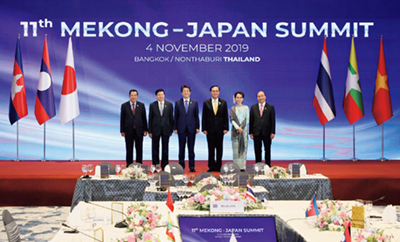
The leaders who attended the Mekong-Japan Summit (November 2019) (Photo: Cabinet Public Relations Office of the Government of Japan)
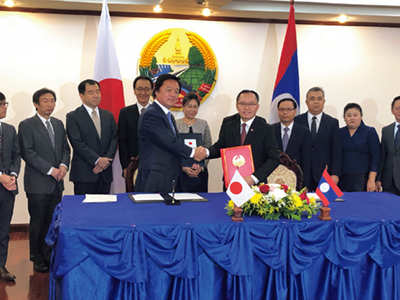
State Minister for Foreign Affairs WAKAMIYA Kenji at the signing ceremony of the Exchange of Notes concerning Grant Aid for the “Project for Expansion of Water Supply System in Luang Prabang” in Laos (October 2019)
Cambodia
Project for Realization of Sustainable Life Environment through mainly the Teaching Practical Environmental Education in Teacher Education College (TEC)
Grant Assistance for Japanese NGO Projects (November 2018 - November 2019)
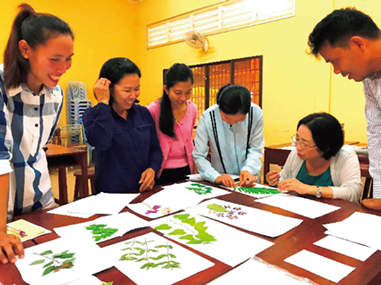
Teachers at a Teacher Education College making handmade environmental education materials using plants from the schoolyard as specimens (Photo: Nature Center Risen)
In Cambodia, rapid development in recent years has caused social problems in such areas as forest conservation, animal and plant protection, proper treatment of waste and drainage, and proper use of pesticides and chemical fertilizers. Meanwhile, the loss of the lives of many intellectuals including teachers during the period of the civil war from the 1970s to the early 1990s resulted in a shortage of human resources in the field of education.
In this project carried out by Nature Center Risen, a Japanese non-profit organization, at the Teacher Education Colleges (TEC) in Phnom Penh and Battambang province, it is expected that publishing textbooks for environmental education and developing human resources who can teach environmental education will lead to the spread of the environmental education practiced in Japan throughout Cambodia. Environmental education will actually be conducted as a general education subject worth one credit (30 hours per year) in the teacher training curriculum, and the teachers’ capacity and quality of environmental education are expected to improve. Positive impressions offered by teachers include, “I also tried practicing environmental education at home and realized that it is a field directly connected to our lives.”
In addition, this project implements environmental education at an eco-school in Battambang province for elementary school students and publishes environmental education books. This makes it possible to learn the importance of environmental conservation from early childhood, and such initiatives are expected to contribute to the building of a sustainable society and the improvement of the living environment. (“Photo Collection” shows how children receive practical environmental education, feeling the connection between the nature of Japan and Cambodia by pretending to be migratory birds.)
Relations with China
ODA to China has played a significant role in strengthening Japan and China relations in recent years as well as in the past. During Prime Minister Abe’s visit to China in October 2018, the Government of Japan announced the termination of Japan’s provision of new ODA to China, and the promotion of a new stage of bilateral cooperation, such as holding dialogues and personnel exchanges in the area of development. This has been announced under the recognition that it is time for Japan and China to work shoulder to shoulder for contributing to the region and international community’s prosperity as equal partners. With this announcement, the adoption of new ODA to China has ended in FY2018, and all ongoing projects that have already been adopted and which last several years will be concluded by the end of FY2021.
In recent years, ODA to China has been limited to areas with genuine needs for cooperation, such as cross-border pollution, infectious diseases, and food safety, which directly affect the lives of the Japanese people. The assistance was carried out as technical cooperation (disbursements of ¥400 million in FY2018)(Note3) and Grant Assistance for Grass-roots Human Security Projects (disbursements of ¥23 million in FY2018).(Note4)
With regard to technical cooperation, for example, Japan is implementing projects to tackle environmental problems focused on air pollution including PM2.5, which has raised concerns about its impact on Japan, and projects to support the drafting of civil laws, patent laws, etc. in China that contribute to facilitating the business activities of Japanese companies operating in China. Furthermore, as a new form of cooperation that takes into account the economic development of China, Japan has recently been providing cooperation in which its costs are borne by China. For example, China bears the costs related to support such as technical cooperation for the China-Japan project for the improvement of diagnosis of asbestos-related cancer, which began in 2018, and for the project for promotion and capacity development of disaster mitigation education in the areas afflicted by the Lushan earthquake that occurred in Sichuan Province in 2013.
With regard to Grant Assistance for Grass-Roots Human Security Projects, in FY2018, Japan implemented assistance in constructing an environmental learning center, which offers hands-on experience to visitors by utilizing the facilities in Wuxi City in Jiangsu Province, where Japanese agricultural support systems and sceptic tanks have been introduced, as a way to support the further establishment of waste separation in China.
- *ASEAN Outlook on the Indo Pacific (AOIP)
- An initiative to create a vision of even closer cooperation in the Indo-Pacific and strengthen ASEAN-centered regional architecture. It is not aimed at creating new mechanisms or replacing existing ones; rather, it is intended to enhance ASEAN’s community building process and to better face challenges arising from the current and future regional and global environments.
- *Master Plan on ASEAN Connectivity 2025
- This is the action plan for strengthening ASEAN connectivity that was adopted at the ASEAN Summit Meeting in 2016 as the successor document to the “Master Plan on ASEAN Connectivity” which set 2015 as its goal year (adopted in 2010). It is positioned as a part of “ASEAN 2025: Forging Ahead Together,” which was adopted in 2015. The document stipulates the five strategic objectives of “Sustainable infrastructure,” “Digital innovation,” “Seamless logistics,” “Regulatory excellence,” and “People mobility,” and presents priority initiatives under each of the strategies.
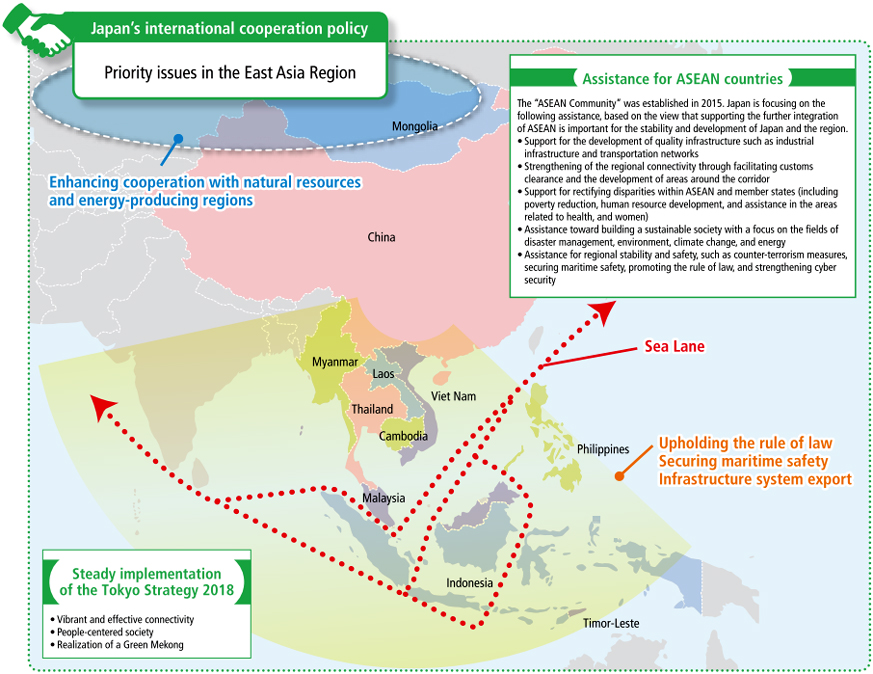
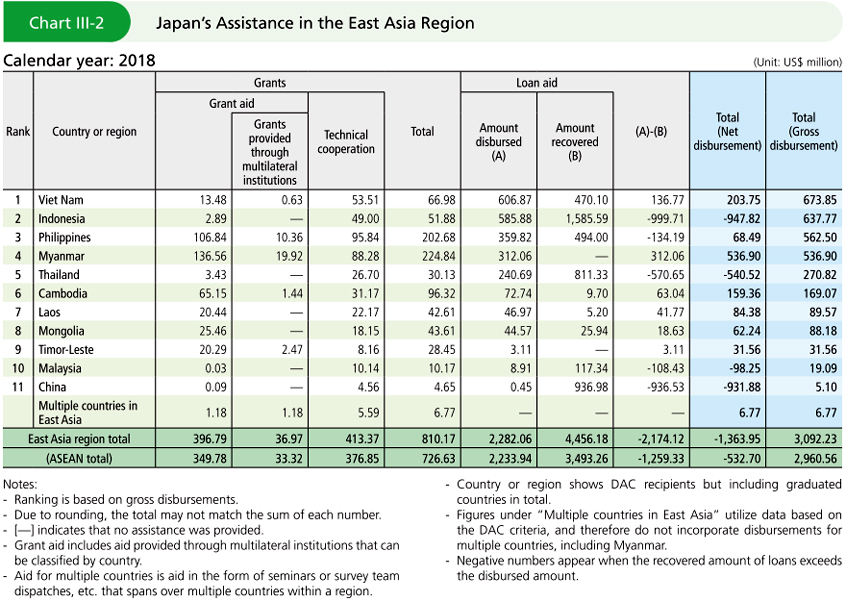
- Note 1: The 10 ASEAN member states are Brunei, Cambodia, Indonesia, Laos, Malaysia, Myanmar, the Philippines, Singapore, Thailand, and Viet Nam (however, Singapore and Brunei are not ODA recipients).
- Note 2: A region including the five countries of Cambodia, Laos, Myanmar, Thailand, and Viet Nam.
- Note 3: Track records of technical cooperation in recent years are as follows:
¥3.296 billion (FY2011), ¥2.527 billion (FY2012), ¥2.018 billion (FY2013), ¥1.436 billion (FY2014), ¥806 million (FY2015), ¥500 million (FY2016), ¥404 million (FY2017), ¥400 million (FY2018) - Note 4: Track records of Grant Assistance for Grass-Roots Human Security Projects in recent years are as follows:
¥843 million (FY2011), ¥288 million (FY2012), ¥284 million (FY2013), ¥85 million (FY2014), ¥107 million (FY2015), ¥29 million (FY2016), ¥9.95 million (FY2017), ¥23 million (FY2018)
